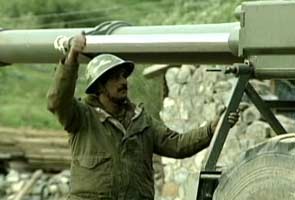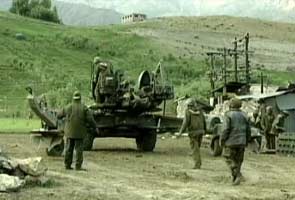Fifty years ago, the Indian Army raised a new formation, primarily to combat insurgency in the north-east. Today, not only it has accomplished its missions in the north-east along with Jammu and Kashmir, but more importantly, won the Kargil conflict for India in 1999.
This is the story of the formation, the 8 Mountain division, which is 'Forever in Operations'.
(Video is here:http://www.ndtv.com/video/player/ndtv-special-ndtv-24x7/the-kargil-victors-8-mountain-division-forever-in-operations/283886?pfrom=home-lateststories)
Headquartered in Khumbathang behind a huge mountain feature, the 8 Mountain Division, ever since it was raised in 1963, has mostly operated in the mountains and delivered results every time. There are numerous tales of valour and dedication of the Indian Army, but what makes 8 Mountain Division stand out is its adaptability.
Under Major General KV Krishna Rao, who later became Chief of Army Staff, the Division moved to fight in east Pakistan to help create Bangladesh. Besides General Rao, this division has produced two more Army Chiefs--General BC Joshi and General VP Malik.
For the first 27 years, it operated in the states of Nagaland and Manipur combating insurgencies, earning the soubriquet - 'Forever in Operations'.

As trouble erupted in Kashmir in the late 80s, the Army headquarters decided to fall back upon the 8 Mountain Division. Major General VP Malik moved it to the Kashmir Valley, making it the spearhead of the counter-insurgency operations.
However, the formation is equated with the 1999 Kargil conflict. Captain Vikram Batra, Anuj Nayyar, Vikrant Thapar and many other became household names for their daring exploits at impossible heights.
During this month 14 years ago, last of the Pakistani intruders were evicted from the heights of Kargil-Drass and Batalik underlining the importance of 8 Mountain Division. Hastily rushed into this sector from Kashmir Valley, it took the might of the Bofors guns and the raw courage of the soldiers to earn a hard-earned victory in the forbidding mountains.
 Its current General Officer Commanding, Major General Shokin Chauhan, says: "The posts are high, the altitude is difficult, the mountains are treacherous, the wind is bad and we have an enemy on the Line Of Control, which has not yet stabilized. So all in all it makes for a very difficult job for our boys to do, but they do it commendably. And I hope, very strongly, that people will recognize the valour of the soldiers of 8 mountain division and accept that the Indian Army soldier is better than the best."
Its current General Officer Commanding, Major General Shokin Chauhan, says: "The posts are high, the altitude is difficult, the mountains are treacherous, the wind is bad and we have an enemy on the Line Of Control, which has not yet stabilized. So all in all it makes for a very difficult job for our boys to do, but they do it commendably. And I hope, very strongly, that people will recognize the valour of the soldiers of 8 mountain division and accept that the Indian Army soldier is better than the best."
The 1999 conflict was also one of those rare battles in which the infantry soldier and artillery guns played almost equal role in overcoming the adversary. At such altitude, the artillery will remain a vital element of warfare.
While the 1999 war may never be repeated, it is essential to keep the memory of those who made the supreme sacrifice alive. Every year on July 26, the Indian Army remembers its heroes, who won the Kargil conflict.
This is the story of the formation, the 8 Mountain division, which is 'Forever in Operations'.
(Video is here:http://www.ndtv.com/video/player/ndtv-special-ndtv-24x7/the-kargil-victors-8-mountain-division-forever-in-operations/283886?pfrom=home-lateststories)
Headquartered in Khumbathang behind a huge mountain feature, the 8 Mountain Division, ever since it was raised in 1963, has mostly operated in the mountains and delivered results every time. There are numerous tales of valour and dedication of the Indian Army, but what makes 8 Mountain Division stand out is its adaptability.
For the first 27 years, it operated in the states of Nagaland and Manipur combating insurgencies, earning the soubriquet - 'Forever in Operations'.

As trouble erupted in Kashmir in the late 80s, the Army headquarters decided to fall back upon the 8 Mountain Division. Major General VP Malik moved it to the Kashmir Valley, making it the spearhead of the counter-insurgency operations.
However, the formation is equated with the 1999 Kargil conflict. Captain Vikram Batra, Anuj Nayyar, Vikrant Thapar and many other became household names for their daring exploits at impossible heights.
During this month 14 years ago, last of the Pakistani intruders were evicted from the heights of Kargil-Drass and Batalik underlining the importance of 8 Mountain Division. Hastily rushed into this sector from Kashmir Valley, it took the might of the Bofors guns and the raw courage of the soldiers to earn a hard-earned victory in the forbidding mountains.
 Its current General Officer Commanding, Major General Shokin Chauhan, says: "The posts are high, the altitude is difficult, the mountains are treacherous, the wind is bad and we have an enemy on the Line Of Control, which has not yet stabilized. So all in all it makes for a very difficult job for our boys to do, but they do it commendably. And I hope, very strongly, that people will recognize the valour of the soldiers of 8 mountain division and accept that the Indian Army soldier is better than the best."
Its current General Officer Commanding, Major General Shokin Chauhan, says: "The posts are high, the altitude is difficult, the mountains are treacherous, the wind is bad and we have an enemy on the Line Of Control, which has not yet stabilized. So all in all it makes for a very difficult job for our boys to do, but they do it commendably. And I hope, very strongly, that people will recognize the valour of the soldiers of 8 mountain division and accept that the Indian Army soldier is better than the best." The 1999 conflict was also one of those rare battles in which the infantry soldier and artillery guns played almost equal role in overcoming the adversary. At such altitude, the artillery will remain a vital element of warfare.
While the 1999 war may never be repeated, it is essential to keep the memory of those who made the supreme sacrifice alive. Every year on July 26, the Indian Army remembers its heroes, who won the Kargil conflict.




















